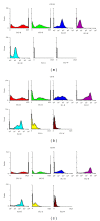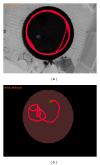Transplanted bone marrow mesenchymal stem cells improve memory in rat models of Alzheimer's disease
- PMID: 22754576
- PMCID: PMC3382392
- DOI: 10.1155/2012/369417
Transplanted bone marrow mesenchymal stem cells improve memory in rat models of Alzheimer's disease
Abstract
The present study aims to evaluate the effect of bone marrow mesenchymal stem cells (MSCs) grafts on cognition deficit in chemically and age-induced Alzheimer's models of rats. In the first experiments aged animals (30 months) were tested in Morris water maze (MWM) and divided into two groups: impaired memory and unimpaired memory. Impaired groups were divided into two groups and cannulated bilaterally at the CA1 of the hippocampus for delivery of mesenchymal stem cells (500 × 10(3)/μL) and PBS (phosphate buffer saline). In the second experiment, Ibotenic acid (Ibo) was injected bilaterally into the nucleus basalis magnocellularis (NBM) of young rats (3 months) and animals were tested in MWM. Then, animals with memory impairment received the following treatments: MSCs (500 × 10(3)/μL) and PBS. Two months after the treatments, cognitive recovery was assessed by MWM in relearning paradigm in both experiments. Results showed that MSCs treatment significantly increased learning ability and memory in both age- and Ibo-induced memory impairment. Adult bone marrow mesenchymal stem cells show promise in treating cognitive decline associated with aging and NBM lesions.
Figures







Similar articles
-
Differences in memory impairment and response to GM1 ganglioside treatment following electrolytic or ibotenic acid lesions of the nucleus basalis magnocellularis.Restor Neurol Neurosci. 1999;15(1):25-37. Restor Neurol Neurosci. 1999. PMID: 12671241
-
The effect of treadmill running on memory before and after the NBM-lesion in rats.J Bodyw Mov Ther. 2013 Oct;17(4):423-9. doi: 10.1016/j.jbmt.2012.12.005. Epub 2013 Jan 11. J Bodyw Mov Ther. 2013. PMID: 24138998
-
Pretraining or previous non-spatial experience improves spatial learning in the Morris water maze of nucleus basalis lesioned rats.Behav Brain Res. 2004 Jan 5;148(1-2):55-71. doi: 10.1016/s0166-4328(03)00182-7. Behav Brain Res. 2004. PMID: 14684248
-
Effects of nerve growth factor treatment on rats with lesions of the nucleus basalis magnocellularis produced by ibotenic acid, quisqualic acid, and AMPA.Exp Neurol. 1995 Dec;136(2):234-50. doi: 10.1006/exnr.1995.1100. Exp Neurol. 1995. PMID: 7498413
-
Effects of mesenchymal stem cells transplantation on cognitive deficits in animal models of Alzheimer's disease: A systematic review and meta-analysis.Brain Behav. 2018 Jul;8(7):e00982. doi: 10.1002/brb3.982. Epub 2018 Jun 6. Brain Behav. 2018. PMID: 29877067 Free PMC article.
Cited by
-
Bone marrow mesenchymal stem cells improve cognitive impairments induced by methamphetamine in rats and reduce relapse.Bioimpacts. 2023;13(2):97-108. doi: 10.34172/bi.2022.23329. Epub 2022 Nov 26. Bioimpacts. 2023. PMID: 37193077 Free PMC article.
-
Stem Cells in Neurological Disorders: Emerging Therapy with Stunning Hopes.Mol Neurobiol. 2015 Aug;52(1):610-25. doi: 10.1007/s12035-014-8883-6. Epub 2014 Sep 23. Mol Neurobiol. 2015. PMID: 25241647 Review.
-
Therapeutic Potential of Experimental Stereotactic Hippocampal Cell Transplant in the Management of Alzheimer's Disease.J Clin Med. 2025 Jan 29;14(3):891. doi: 10.3390/jcm14030891. J Clin Med. 2025. PMID: 39941562 Free PMC article. Review.
-
Advances in stromal cell therapy for management of Alzheimer's disease.Front Pharmacol. 2022 Oct 4;13:955401. doi: 10.3389/fphar.2022.955401. eCollection 2022. Front Pharmacol. 2022. PMID: 36267273 Free PMC article. Review.
-
Hepatic and cardiac implications of increased toxic amyloid-beta serum level in lipopolysaccharide-induced neuroinflammation in rats: new insights into alleviating therapeutic interventions.Inflammopharmacology. 2023 Jun;31(3):1257-1277. doi: 10.1007/s10787-023-01202-3. Epub 2023 Apr 5. Inflammopharmacology. 2023. PMID: 37017850 Free PMC article.
References
-
- Alcyr A, Oliveira JR, Hodges HM. Alzheimer’s disease and neural transplantation as prospective cell therapy. Current Alzheimer Research. 2005;2(1):79–95. - PubMed
-
- Marin DB, Sewell MC, Schlechter A. Alzheimer’s disease: accurate and early diagnosis in the primary care setting. Geriatrics. 2002;57(2):36–40. - PubMed
-
- Terry RD, Masliah E, Salmon DP, et al. Physical basis of cognitive alterations in Alzheimer’s disease: synapse loss is the major correlate of cognitive impairment. Annals of Neurology. 1991;30(4):572–580. - PubMed
-
- Jeffrey L, Cummings MD. Cognitive and behavioral heterogeneity in Alzheimer’s disease: seeking the neurobiological basis. Neurobiology of Aging. 2000;21(6):845–861. - PubMed
-
- Crook TH, T. Bartus R, H. Ferris S. Age-associated memory impairment. Developmental Neuropsychology. 1986;2:261–276.
LinkOut - more resources
Full Text Sources
Miscellaneous

